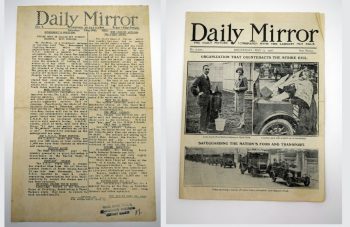Administrative/Biographical History
The General Strike was a major event in British society during the 1920s and can be seen as a flashpoint of a turbulent era concerning industrial relations. Economic times were tough in Britain after the First World War and there was a growing fear of Communism. The strike originated as an industrial dispute between the miners and the mine owners, over reduced pay for more hours work. When the Trades Union Congress (TUC) declared their support for the strike, other industrial workers including those in road transport, rail, docks, electricity and gas, printers, and iron and steel all walked out and it became the first every General Strike for Britain. The strikers wanted to force the government to intervene and stop the mine owners from increasing their daily hours from 7 to 8 hours whilst reducing wages by 13%.
The first few days of the strike saw the transport network grind to a halt without bus and train drivers and food deliveries were delayed. The army stepped in quickly and along with volunteers got some transport moving again.
Over the 9 days that the strike lasted there were clashes between strikers and police in London, Liverpool and Hull. The government reacted by trying to take control of the media and published its own propaganda newspaper ‘The British Gazette’, which was highly patriotic and critical of the strikers. The TUC then decided to print its own paper – the ‘British Worker’ but circulation for The British Gazette was much greater.
9 days after it began, the TUC called off the strike, following secret discussions with the mine owners. The miners had won no concessions for their cause. The strikers slowly returned to work apart from the miners who struggled on until November, eventually having to return to work with less money and more hours. The Trades Disputes Act was passed the following year – mass picketing and sympathy strikes were banned. The Act was repealed in 1946 but reintroduced in the Employment Act 1980 by Margaret Thatcher.
Sources
Pamphlet Collection – ref 331.81, 2 boxes that include numerous reports on the events that unfolded, before, during and in the immediate aftermath of the general strike. In many cases the different pamphlets originate from different parts of the country and as a result, different pamphlets will give a slightly different insight than the others in the collection.
General Strike Newspaper Collection- The collection includes a number of newspapers and publications that reported the events of the general strike while exploring the immediate aftermath. Includes The British Gazette, The British Worker, Manchester Guardian, and The Miner (NMLH/GS).
Acc 1377 – General Strike newspapers including Daily Mail, The Manchester Gazette, MEN Bulletin and Manchester Emergency Echo
Acc 1463 – General Strike newspapers including Evening Standard, Daily Sketch, Hendon, Cricklewood and Golders Green Gazette and Daily Mirror
Communist Party of Great Britain- A large amount of material originating from the National Minority Movement (CP/CENT/IND/11/03) and the Miners Minorities Movement (CP/CENT/IND/11/06). This collection includes titles such as “One Mineworkers Union, Why?” and “The Miners Next Task”.
Labour Party Annual Report – The 1926 Labour Party Conference Report includes descriptions about committees and subcommittees that aimed at debating whether the Party should nationalise the mines while considering the best way forward after the impact of the General Strike.
Labour Party Photographic Collection: Photos from the General Strike and different demonstrations around the country with some photos depicting other strikes in the lead up to 1926.
Communist Party of Great Britain Photographic Collection- This collection includes a range of photos from the General Strike (Box 48) as well as some general photos of miners (Box 45) and their work places, both from before and after the General Strike in 1926.
Related material
There are a number of reference books in the reading room, classification no. 331.81

Explore PHM’s General Strike collections on an archive exploration day.
Find out more